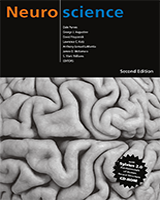By agreement with the publisher, this book is accessible by the search feature, but cannot be browsed.
NCBI Bookshelf. A service of the National Library of Medicine, National Institutes of Health.
Purves D, Augustine GJ, Fitzpatrick D, et al., editors. Neuroscience. 2nd edition. Sunderland (MA): Sinauer Associates; 2001.

Neuroscience. 2nd edition.
Show detailsEffective synaptic transmission requires close control of the concentration of neurotransmitters within the synaptic cleft. Neurons have therefore developed a sophisticated ability to regulate the synthesis, packaging, release, and degradation (or removal) of neurotransmitters to achieve the desired levels of transmitter molecules (Figure 6.6A). In general, each of these component processes is specific to the transmitter involved, requiring enzymes found only in (or in association with) neurons that use the transmitter at their synapses.

Figure 6.6
The synthesis, packaging, secretion, and removal of neurotransmitters. (A) The life cycle of transmitter agents entails (1) neurotransmitter synthesis, (2) packaging into vesicles, (3) fusion of vesicles resulting in neurotransmitter release, and (4) (more...)
As a rule, the synthesis of small-molecule neurotransmitters occurs within presynaptic terminals (Figure 6.6B). The enzymes needed for transmitter synthesis are synthesized in the neuronal cell body and transported to the nerve terminal cytoplasm at 0.5–5 millimeters a day by a mechanism called slow axonal transport. The precursor molecules used by these synthetic enzymes are usually taken into the nerve terminal by transporter proteins found in the plasma membrane of the terminal. The enzymes generate a cytoplasmic pool of neurotransmitter that must then be loaded into synaptic vesicles by transport proteins in the vesicular membrane (see Chapter 4). For some small-molecule neurotransmitters, the final synthetic steps actually occur inside the synaptic vesicles.
The mechanisms responsible for the synthesis and packaging of peptide transmitters are fundamentally different from those used for the smallmolecule neurotransmitters (Figure 6.6C). Peptide-secreting neurons generally synthesize polypeptides in their cell bodies that are much larger than the final, “mature” peptide. Processing these polypeptides, which are called pre-propeptides (or pre-proproteins), takes place by a sequence of reactions in several intracellular organelles. Pre-propeptides are synthesized in the rough endoplasmic reticulum, where the signal sequence of amino acids—that is, the sequence indicating that the peptide is to be secreted—is removed. The remaining polypeptide, called a propeptide (or proprotein), then traverses the Golgi apparatus and is packaged into vesicles in the trans-Golgi network. The final stages of peptide neurotransmitter processing occur after packaging into vesicles and involve proteolytic cleavage, modification of the ends of the peptide, glycosylation, phosphorylation, and disulfide bond formation.
Neuropeptide synthesis is, therefore, much like the synthesis of proteins secreted from non-neuronal cells (pancreatic enzymes, for instance). A major difference, however, is that the neuronal axon often presents a very long distance between the site of a peptide's synthesis and its ultimate secretion. The peptide-filled vesicles must therefore be transported along the axon to the synaptic terminal. The mechanism responsible for such movement, known as fast axonal transport, carries vesicles at rates up to 400 mm/day along cytoskeletal elements called microtubules (in contrast to the slow axonal transport of the enzymes that synthesize small-molecule transmitters). Microtubules are long, cylindrical filaments, 25 nm in diameter, present throughout neurons and other cells. Peptide-containing vesicles are moved along these microtubule “tracks” by ATP-requiring “motor” proteins such as kinesin.
- Neurotransmitter Synthesis - NeuroscienceNeurotransmitter Synthesis - Neuroscience
Your browsing activity is empty.
Activity recording is turned off.
See more...